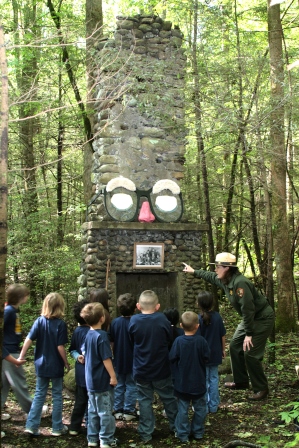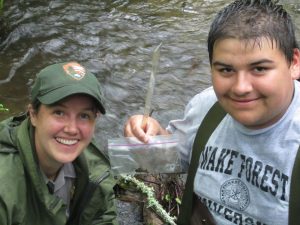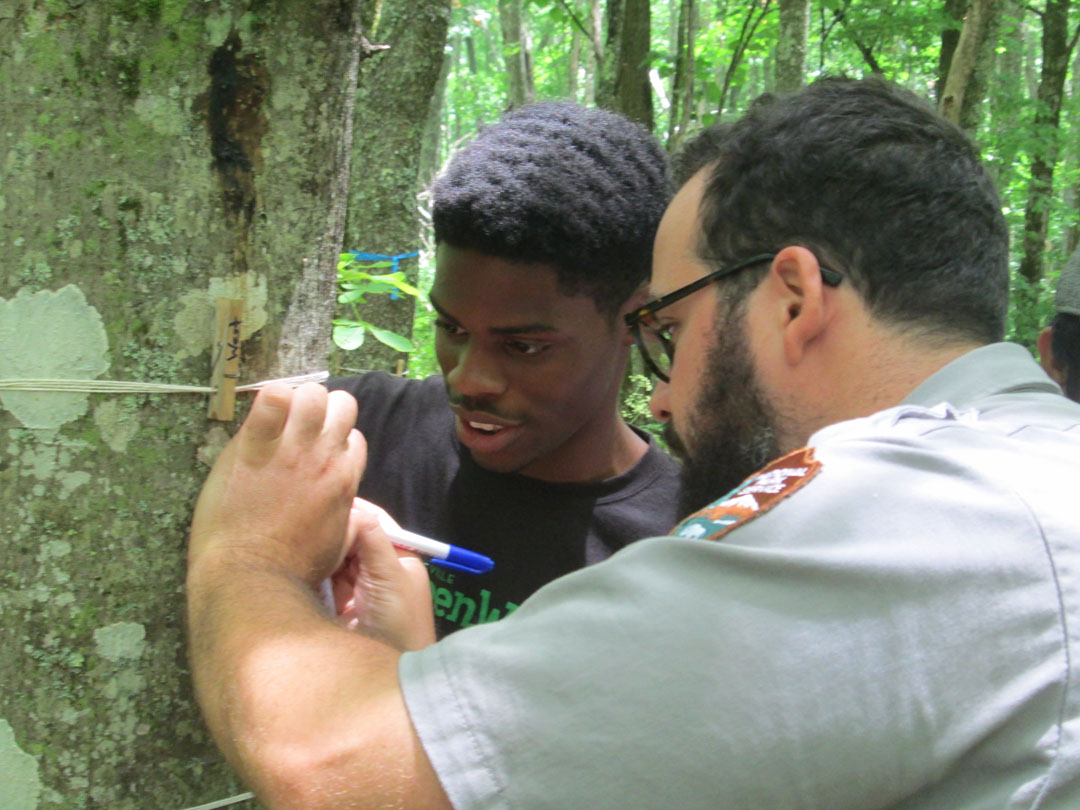by Julie Dodd
Helping elementary, middle school and high school students who live in counties near the Great Smoky Mountains National Park discover the Park and develop an appreciation of the outdoors is a primary goal of Parks as Classrooms (PAC).
“Those students are our future stewards, and it’s important that they are falling in love with our national parks,” said Joy Absher, Park Ranger and Acting Education Branch Chief. “Through the Parks as Classrooms program, they will see the value of public lands.”
In the Fiscal Year 2016 (Oct. 1, 2016 to Sept. 30, 2017), the Parks as Classrooms program served 14,900 students and 2,015 adults (teachers and chaperones), with a total of 428 classes participating.
The program also served an additional 3,763 students at Conservation Field Days and special schools events or programs during the school year.
Making field trips possible
Of the total number of students, 3,028 students were from inner city title I schools in Knoxville, meaning that many of the children are from low-income families. For those students, Parks as Classrooms is the only way they will visit the Great Smoky Mountains National Park.
Absher explained that for low-income families, the cost of gas to drive to the park keeps them from being able to experience the park as a family trip.
The Parks as Classrooms program, with funding from Friends of the Smokies, helps make the field trip to the Park possible by paying the $250-$300 cost of a bus. The policy in some school districts is to not ask students and their parents to contribute toward a field trip because that creates an awkward situation for those families that can’t afford to make a contribution.
Being able to provide the bus enables the students to participate and eliminates fundraising activities that teachers often have to undertake to pay for field trips. In some cases, Absher said, the teachers were paying for the buses themselves.
Connecting to state education standards

The Parks as Classrooms program is designed to connect with state education standards. The program also provides an energizing experience for both students and teachers. Kelsey Reese, an Ecology and Biology teacher at Fulton High School in Knox County, wrote about the experience in a FOTS blog post.
The GSMNP education staff studies the state-mandated learning standards in North Carolina and Tennessee (the two states that encompass the park). The staff also works with teachers to connect the learning activities in the park to the standards.
The educational staff develops the grade-level specific curriculum based on the standards and input from teachers. A trail run of the activity enables the staff to make adjustments before making the program available to teachers.
“We work on understanding the needs of the teachers and the needs of the curriculum,” Absher said. “We coordinate a lot with the teachers we are working with.”
In the elementary grades, learning about the five senses is an objective. The Parks as Classrooms curriculum helps students put their senses into practice. Activities includes the Talking Pine Tree in Cades Cove, the Talking Chimney at the Sugarlands Visitor Center, and the Talking Barn at the Oconaluftee Visitor Center. The students visit different locations in each area to learn about animals and plants.
“They also learn how we take care of national parks,” Absher said.
Being part of Citizen Science projects
Older students participate in Citizen Science projects, collecting and recording data. The Salamander Research Field Trip, designed for students in high school and upper grades of middle school, is one example of a Citizen Science project.

“The students are learning and helping out. Collecting scientific data that they know will be used gives even deeper meaning to what they are doing. This taps into service learning,” Absher said.
“In that age group, it is so important for the students to feel like they are giving back. They want to feel like they’re useful to a bigger cause or issue in the world.”
The Great Smoky Mountains National Park is the Salamander Capital of the world. Salamanders are so sensitive to environmental factors that monitoring them on a long-term basis helps rangers and university researchers determine the environmental health of the park. By studying salamanders, students learn about the pH level of the soil and the amount of mercury in the water.
“The kids really get into the projects. They aren’t thinking about what’s going on in their home lives or issues with their friends. They are having those moments of peace – almost like meditation for them. I love seeing those moments. That sticks with them, too. They remember that ‘I had a good feeling in the park.’”
The photo at the top of the post is another example of a Citizen Science Project connected with Parks as Classrooms. Ninth grade students help monitor lichen populations in an long-term study looking at the impact from acid rain.
The educational specialists in the park create lesson plans and provide activities teachers and students complete before coming to the park to help them be better prepared for a great learning experience. For some projects, the rangers come to the classroom before the field trip to work with the students and teachers.
Helping fund Parks as Classrooms

The Parks as Classrooms program and part of the salaries for seasonal and regular staff is funded by Friends of the Smokies.
Already all the current Parks as Classrooms (PAC) opportunities are filled for 2017-2018 school year. Contributions that are made to FOTS designated to the Parks as Classrooms program can help in making the park learning experience available to more students.
The school districts with Title I schools targeted for the Parks as Classrooms program include Blount, Cocke, Jefferson, Knox and Sevier counties in Tennessee and Buncombe, Haywood and Swain counties in North Carolina.
FOTS also funds the Teacher Ranger Teacher (TRT) program that provides professional development for K-12 teachers. Teachers learn about the resources available through the GSMNP and develop teaching materials connected with place-based learning in the park.
Visit the Parks as Classrooms website to read about learning projects and GSMNP field trips.
